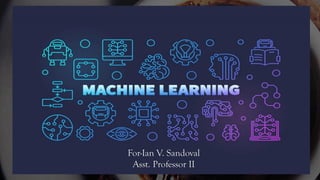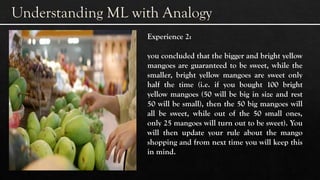Machine Learning Algorithms (Part 1)
- 2. DIFFERENTIATE ARTIFICIAL INTELLIGENCE, MACHINE LEARNING AND DEEP LEARNING 01 UNDERSTAND THE NEED FOR MACHINE LEARNING 02 ILLUSTRATE MACHINE LEARNING PROCESS 03
- 3. UNDERSTAND THE TYPES OF MACHINE LEARNING 04 DETERMINE THE TYPE OF PROBLEMS SOLVED USING MACHINE LEARNING 05 PRACTICAL IMPLEMENTATION OF MACHINING LEARNING 06
- 4. • It covers anything which enables the computers to behave like humans. • It deals with the extraction of patterns from a large data sets. • It deals to train Deep Neural Networks so as to achieve better accuracy in those cases where former was not performing up to the mark.
- 5. •2.5 quintillion bytes of data every single day •Estimated by 2020, 1.7MB of data will be created every second for every person on earth. •predictive models that can study and analyze complex data Source: Google Images •Netflix and Amazon
- 7. Netflix’s Recommendation Engine Facebook’s Auto-tagging feature Amazon’s Alexa Google’s Spam Filter
- 8. Task: How will you choose the best mangoes?
- 9. Experience 1: You were informed that bright and yellow mangoes are sweeter than pale and yellow ones. So you make a simple rule: pick only from the bright yellow mangoes. You check the colour of the mangoes, pick the bright yellow ones, pay up, and return home. Right? Learning 1: Bright yellow mangoes are sweeter than pale yellow ones
- 10. Experience 2: Now when you went home and tasted the mangoes, some of them were not sweet as you thought. You are worried as your wisdom was insufficient. You concluded that when it comes shopping mangoes, you have to look for more than just the colors. After a lot of pondering and tasting different types of mangoes,
- 11. Experience 2: you concluded that the bigger and bright yellow mangoes are guaranteed to be sweet, while the smaller, bright yellow mangoes are sweet only half the time (i.e. if you bought 100 bright yellow mangoes (50 will be big in size and rest 50 will be small), then the 50 big mangoes will all be sweet, while out of the 50 small ones, only 25 mangoes will turn out to be sweet). You will then update your rule about the mango shopping and from next time you will keep this in mind.
- 12. Experience 2: you concluded that the bigger and bright yellow mangoes are guaranteed to be sweet, while the smaller, bright yellow mangoes are sweet only half the time (i.e. if you bought 100 bright yellow mangoes (50 will be big in size and rest 50 will be small), then the 50 big mangoes will all be sweet, while out of the 50 small ones, only 25 mangoes will turn out to be sweet). You will then update your rule about the mango shopping and from next time you will keep this in mind.
- 13. Learning 2: The smaller and bright yellow mangoes are sweet only half the time.
- 14. Experience 3: Tragedy: Next time at the market, you see that your favorite vendor has gone out of town. You decide to buy from a different vendor, who supplies mangoes grown from a different part of the country. Now, you realize that the rule which you had learnt (that big, bright yellow mangoes are the sweetest) is no longer applicable. You have to learn from scratch. You taste a mango of each kind from this vendor and realize that the small, pale yellow ones are in fact the sweetest of all. Learning 3: Small, pale yellow ones are the sweetest of all.
- 15. Experience 4: One day your cousin visits you from another city. You decide to treat her with mangoes. But she is like “I don’t care about the sweetness of a mango, I only want the juiciest ones”. Now once again, you run your experiments, tasting all kinds of mangoes, and realizing that the softer ones are juicier. Learning 4: Soft mangoes are juicier
- 16. Experience 5: Later on, you move to a different part of the world and you found that the mangoes here taste surprisingly different from your home country. You realized that for this country the green mangoes are tastier than the yellow ones. Learning 5: Green mangoes are tastier than yellow one
- 17. Experience 6: You marry someone who hates mangoes but loves oranges instead. Now you go for shopping oranges instead of mangoes. Now, all your accumulated knowledge about mangoes is worthless. Now you have to learn everything about the correlation between the physical characteristics and the taste of apples, by the same method of experimentation. Learning 6: You don’t need mangoes anymore
- 18. What if you have to write a code for it?
- 19. if is bright yellow and size is big and sold by: mango is sweet. if (soft): mango is juicy
- 21. But every time you make a new observation from your experiments, you have to modify the list of rules manually.
- 22. Task: How will you choose the best apple?
- 23. This is where Machine Learning comes into the picture
- 24. “Machine Learning is a concept which allows the machine to learn from examples and experience, and that too without being explicitly programmed. So instead of you writing the code, what you do is you feed data to the generic algorithm, and the algorithm/machine builds the logic based on the given data.”
- 25. • an American pioneer in the field of computer gaming and artificial intelligence Arthur Lee Samuel • popularized the term "machine learning" in 1959
- 26. Training Phase Testing Phase
- 27. Model: A model is the main component of Machine Learning. A model is trained by using a Machine Learning Algorithm. An algorithm maps all the decisions that a model is supposed to take based on the given input, in order to get the correct output. Predictor Variable: It is a feature(s) of the data that can be used to predict the output. Response Variable: It is the feature or the output variable that needs to be predicted by using the predictor variable(s).
- 28. Training Data: The Machine Learning model is built using the training data. The training data helps the model to identify key trends and patterns essential to predict the output. Testing Data: After the model is trained, it must be tested to evaluate how accurately it can predict an outcome. This is done by the testing data set.
- 31. Step 1: Define the objective of the Problem Statement • At this step, we must understand what exactly needs to be predicted. • In our case, the objective is to predict the possibility of rain by studying weather conditions. • At this stage, it is also essential to take mental notes on what kind of data can be used to solve this problem or the type of approach you must follow to get to the solution.
- 32. Step 2: Data Gathering • What kind of data is needed to solve this problem? • Is the data available? • How can I get the data?
- 33. Step 4: Exploratory Data Analysis • Grab your detective glasses because this stage is all about diving deep into data and finding all the hidden data mysteries. EDA or Exploratory Data Analysis is the brainstorming stage of Machine Learning. • Data Exploration involves understanding the patterns and trends in the data. • At this stage, all the useful insights are drawn and correlations between the variables are understood.
- 34. Step 5: Building a Machine Learning Model • All the insights and patterns derived during Data Exploration are used to build the Machine Learning Model. • This stage always begins by splitting the data set into two parts, training data, and testing data. • The training data will be used to build and analyze the model. • The logic of the model is based on the Machine Learning Algorithm that is being implemented.
- 35. Step 6: Model Evaluation & Optimization • After building a model by using the training data set, it is finally time to put the model to a test. • The testing data set is used to check the efficiency of the model and how accurately it can predict the outcome. • Once the accuracy is calculated, any further improvements in the model can be implemented at this stage. • Methods like parameter tuning and cross-validation can be used to improve the performance of the model.
- 36. Step 7: Predictions • Once the model is evaluated and improved, it is finally used to make predictions. • The final output can be a Categorical variable (eg. True or False) or it can be a Continuous Quantity (eg. the predicted value of a stock).
- 37. 1. Supervised Learning 2. Unsupervised Learning 3. Reinforcement Learning
- 38. • a technique in which we teach or train the machine using data which is well labeled.
- 40. • Y = f(X) • every instance of the training dataset consists of input attributes and expected output
- 41. • The training dataset can take any kind of data as an input like values of a database row, the pixels of an image, or even an audio frequency histogram.
- 43. • involves training by using unlabeled data and allowing the model to act on that information without guidance
- 45. • input data (X) and no corresponding output variables • to model the underlying structure or distribution in the data in order to learn more about the data.
- 46. • dataset does not have an expected • can detect patterns based on the typical characteristics of the input data • Clustering
- 48. • a part of Machine learning where an agent is put in an environment and he learns to behave in this environment by performing certain actions and observing the rewards which it gets from those actions
- 49. • hit and trial method of learning • all about the interaction between the environment and the learning agent • exploration and exploitation





















































